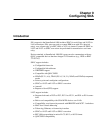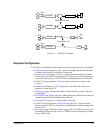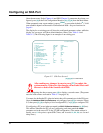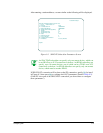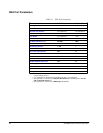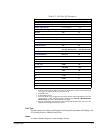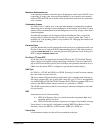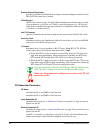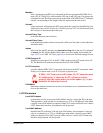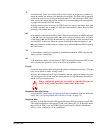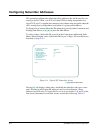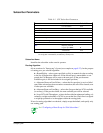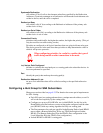
Configuring SNA 9-9
Maximum Retransmissions
is the maximum number of times the port will attempt to send a frame if the PU is not
responding. A larger value increases the probability of an eventual correct transfer
between DTE and DCE, but a smaller value permits faster detection of a permanent
error condition.
Outstanding Frames
also called level 2 window size, is the maximum number of sequentially numbered
frames that can be waiting for acknowledgment. If this number is exceeded, no more
frames will be transmitted until an acknowledgment is received. A larger value allows
faster throughput.
Note that this parameter can be changed without disabling the link, except if the
existing value is within the range
0–7
and the new value is greater than 7. (
0–7
is
modulus 8 or 128; anything greater is only modulus 128. Changing the modulus will
disable the link.)
Generate Clock
specifies whether the port will generate the clock necessary to synchronize traffic over
the link. If the port is a physical DCE (determined by the port's I/O cable interface),
configure
Generate Clock
as
Y
, since the physical DCE generates clock. If the port is
DTE, configure
Generate Clock
as
N
.
Rcv Clock (TT) from DTE
allows the clock to be looped back from the DTE using the TT (Terminal Timing)
signal, which can be helpful on high-speed lines. Generally, if the local interface is
physical DCE and the line speed is above 256 Kbps, this parameter should be set to
Y
.
(Make sure the remote DTE is configured to provide the terminal timing.)
SNA Type
0
= XPAD,
1
= TPAD,
2
= HPAD,
3
= NPAD. Pressing
[L]
at the Port screen changes
the value to the next one in the list.
The most common SNA networking requirement is for communication between an
SNA host computer (PU type 4) and control units (PU type 2). This is accomplished
via an HPAD (Host PAD) and TPAD (Terminal PAD). The host computer FEP is con-
nected to the HPAD and the cluster controller is connected to a TPAD.
The XPAD is particularly useful for networking of statistical multiplexers and other
bit-sync devices.
NRZ
determines the level of data encoding:
Y
= NRZ (Non-Return to Zero) on, which means that
1
represents high-level
encoding and
0
is low-level.
N
= NRZ off, which means that
1
represents no change in level and
0
is a change.
Unless there is a site-specific configuration needing NRZI (Non-Return to Zero
Inverted), always use NRZ for all SNA modes. (NRZ off = NRZI on.)
Packet Size
is the maximum packet size that will be transmitted on the port.



